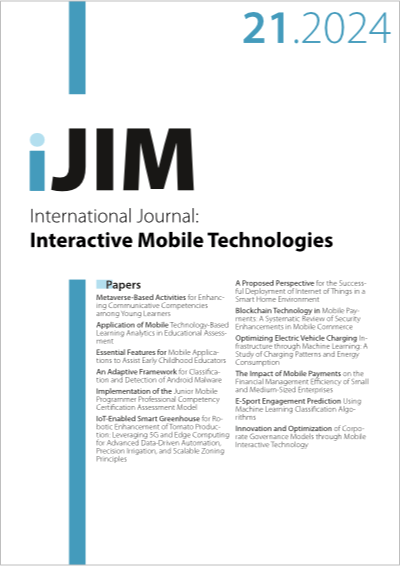IoT-Enabled Smart Greenhouse for Robotic Enhancement of Tomato Production: Leveraging 5G and Edge Computing for Advanced Data-Driven Automation, Precision Irrigation, and Scalable Zoning Principles
DOI:
https://doi.org/10.3991/ijim.v18i21.50829Keywords:
Internet of Things (IoT), Smart System, Tracking System, sensor, Agriculture Greenhouse Technology, Tomato CultivationAbstract
There are many difficulties in growing tomatoes, such as erratic weather patterns, variable yields, and short shelf lives. Tomatoes are a staple food that is grown all throughout the world, particularly in climate-friendly areas such as Morocco. These areas are not free from the difficulties that present major obstacles for farmers, though. Modern agricultural techniques are increasingly using cutting-edge technologies, such as Internet of Things (IoT)-enabled smart greenhouses, to address these problems. In order to improve tomato output, this study presents an enhanced smart greenhouse model that incorporates the zoning principle. The method provides optimal plant growth and resource efficiency by separating the greenhouse into various zones, each tailored for specific growth stages and environmental circumstances. Precision farming and sustainable practices are made possible by the suggested systems real-time monitoring and control, which integrates sensors, actuators, and data analytics. The automatic irrigation system of the intelligent greenhouse prototype is additionally set up to offer the best possible support for the growth of tomato plants. The functionality and efficacy of the prototype are investigated through extensive laboratory testing and experimentation, providing insight into its potential influence on agricultural practices and practical practicality. The greenhouse that has been created with the help of IoT capabilities and the zoning concept has proven to be an effective instrument in assisting farmers in their attempts to grow tomatoes in an efficient and sustainable manner. Our comprehensive testing yielded data that demonstrate the zoning principle-integrated IoT-enabled smart greenhouse greatly improves tomato quality and production. This system demonstrates the benefits and practical applicability of sophisticated data-driven automation in agriculture by providing a scalable and sustainable solution to the problems encountered by tomato producers.
Downloads
Published
How to Cite
Issue
Section
License
Copyright (c) 2024 Anass ARISS, Imane Ennejjai, Asmaa Lamjid, Nassim Kharmoum, Soumia Ziti

This work is licensed under a Creative Commons Attribution 4.0 International License.



